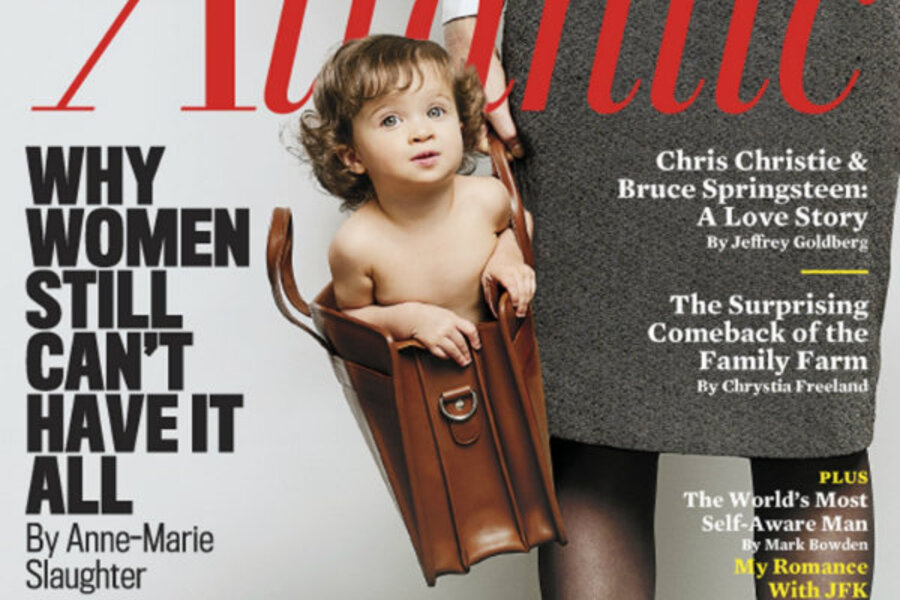'Having it all' is so 1980s
| Brooklyn, N.Y.
The latest spike in the “have it all” debate is characteristically out of touch with the reality of what modern families are like and how they function. White, privileged, heterosexual, and married, we are a poster pair for the discussion. And yet the ongoing buzz surrounding Anne-Marie Slaughter’s recent Atlantic cover story on whether – and how – women can balance career success with family doesn’t accurately encapsulate even our experience or ambition.
According to the Council for Contemporary Families, close to half of US residents 18 and older are single. Between 1965 and 2003, men tripled the amount of time they spent on childcare. At least 1 in 7 children live with a parent who had lost his or her job. US census data for 2000 suggests more than 250,000 children are being raised by lesbian and gay parents. The world, as reflected in this latest iteration of the “have it all” debate, simply doesn’t cover the challenges and choices many families face.
As we look toward the next stage of our lives (more diapers, less dining out), we’ve been thinking a lot about where and how to live – our own “have it all” debate.
A daughter and a son of middle class Midwesterners, we’ve been dreaming about how we might remix the best of the families we grew up in – Courtney’s parents’ undying curiosity, John’s parents’ spirit of service – for our own moment.
In the 1980s, when we were coming of age, it made sense for our parents to strive and struggle with full-time work and co-parenting; they were in step with the more, better, faster times – aspiring to make more money than their parents had (our mothers were the first women in their respective families to work after giving birth) and own their own suburban homes, with a garage for two family cars. They raised us, and their other children, to dream bigger than they’d ever dared.
But a funny thing happened along the way: Big became less sexy – at least to us. We’re living in the hangover of the ambition-drunken times in which we came of age. We’re attuned – not to acquisition or status, but to core joys: family and friends around us, careers aimed at making the world a better place, as well as a lot of flexibility, and enough money to live without insecurity, but not so much that it becomes a focus of our days.
Truth be told, our dreams aren’t all that big: We want a small, comfortable house; hope to own only one car (neither of us have had a car for years), and never want job titles that require us to miss out on important moments with our friends and family.
Our question is not, how can we – husband and wife considering children – have it all? Our question is, how can we have enough? We believe the latter is a much more worthwhile question, and one that will lead us not down a black hole of debate, but toward more fulfilling, fun lives – for us and our children.
We aspire to continue what we call our communal life. Our community is not necessarily a place, after all; it is a cozy, little node in a much larger network. We dream about raising our kids near some of our dearest friends and our siblings a short flight or drive away.
Mary and Chris can teach them about poetry, Jody and Aaron about design, Auntie Jen about science and sex. As anthropologist Margaret Mead once said, “Nobody has ever before asked the nuclear family to live all by itself in a box the way we do. With no relatives, no support, we’ve put it in an impossible situation.”
We don’t want the impossible. We don’t want to have it all. We want to be happy and helpful.
Our newest role models for this kind of “it takes a village” lifestyle come from an unlikely place. We’ve had two close friends recently have babies on their own by choice, and it’s been inspiring to watch as their motley crew of friends and family members weave in and out of their lives – taking night shifts here, planning baby showers there, being on call for whatever, whenever.
Even with four hands on deck, we hope to adopt that kind of interdependent ethos when we have kids. It will require some vulnerability, some spontaneity, but the reward we expect is profound – a sense that your community is wide and willing.
The day after Thanksgiving last year, John’s parents rented out a whole bowling alley in Milwaukee, Wis., and his big, Catholic family took it over for the day. There were 18 of us – everyone from Grandma Audrey, 84 years old, to baby Audrey, 2 years old, Courtney’s brother, a poet, to John’s, a sports agent. Our scores weren’t very impressive, but it was one of the best days of our year.
If having it all means bowling alone, as sociologist Robert Putnam would put it, then consider us uninterested.
Courtney E. Martin is co-author of “Perfect Girls, Starving Daughters: How the Quest for Perfection is Harming Young Women,” among other books, and a TED speaker. John Cary is editor of PublicInterestDesign.org and author of “The Power of Pro Bono: 40 Stories about Design for the Public Good by Architects and Their Clients.” Follow Courtney on Twitter at @courtwrites. Follow John at @johncary.





